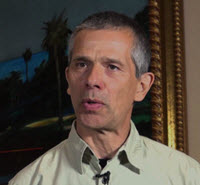Markus Huettel gives an overview of the project at the Gulf of Mexico Oil Spill & Ecosystem Science Conference January 2016
The A systems approach to improve predictions of biodegradation and ecosystem recovery in coastal marine sediments impacted by oil spill project is lead by P.I. Markus Huettel, Florida State University.
After coastal oil spills, petroleum hydrocarbons accumulate in submerged nearshore sediments and on beaches, poisoning these ecosystems and creating health risks for coastal organisms and humans. Erosion and deposition cycles lead to burial of weathered crude oil in submerged shelf beds, intertidal sediments, and dry beach sands. Prediction of the effects and fate of these buried petroleum hydrocarbons remains hampered by our limited understanding of the controls of the biodegradation and functioning of sedimentary microbial communities that break down petroleum hydrocarbons. Transport of oxygen and nutrients to the buried oil is expected to control the rates of hydrocarbon biodegradation. While the flow of air through dry beach sands can rapidly transport oxygen to buried oil, it cannot carry nutrients that are limiting the degradation of the oil. Transport via pore water flows in submerged sand beds is slower than the gas transport in dry sand, but water can transport dissolved nutrients to buried hydrocarbons. It is therefore hypothesized that microbial oil degradation in dry, temporally wet and water-saturated sediments differ. A quantitative understanding of the mechanisms controlling these differences is a central prerequisite for the modeling of oil decomposition in these coastal ecosystems. The main goals of this project therefore are to link microbial degradation of buried oil and associated transport processes, and to integrate these data in a model that allows predictions of pathways and rates of oil degradation, and thus, forecasting recovery pathways in future oil spills. Specific objectives are to:
1. Determine microbial community structure and succession associated with petroleum hydrocarbons buried in sub-, inter- and supratidal coastal sands using in-situ measurements and controlled laboratory mesocosm incubations that simulate in-situ conditions.
2. Quantitatively link supply rates of oxygen and nutrients to microbial oil degradation rates and community structure in these sands.
3. Develop a model using a systems approach that incorporates microbiological, genomics, biogeochemical and transport data to predict decomposition rates of buried oil in sub, inter- and supratidal beach sands.
4. Organize a two-day workshop for disseminating our models and associated bioinformatics tools for multi-omics data analysis and integration to the GoMRI research community.
This project that contributes to GoMRI RFP V research theme (2) couples cutting-edge microbiological and geochemical approaches in the field with targeted laboratory experiments, genomic analyses and predictive mathematical modeling. In the experiments, biodegradation rates of specific hydrocarbon compounds are linked to the metabolic potential of microbial groups using a combination of metagenomic and metatranscriptomic sequencing and culture-based physiological and genetic manipulations. A distinguishing aspect of this research is that it will integrate taxonomic, genetic and functional data from complex, multivariate experiments into advanced dynamic models that will represent responses of whole microbial communities and allow predictions of their activities under different levels of oxygen and nutrients. The broader impact of this research is related to the potential environmental and health risks associated with petroleum hydrocarbons still persisting in the coastal environment. Covered by anoxic sediment, oil may persist in largely un-weathered form and thus may contain relatively large concentrations of harmful oil components (PAHs) that can be released during storm events. The project will produce tools (e.g., models and microbial indicators of oil degradation) for environmental managers and decision makers that can help planning responses to future oil spills.
Click for access to GoMRI’s YouTube videos of RFP-V Projects…
This project was funded by the Gulf of Mexico Research Initiative (GoMRI) in the RFP-V funding program.
The Gulf of Mexico Research Initiative (GoMRI) is a 10-year independent research program established to study the effect, and the potential associated impact, of hydrocarbon releases on the environment and public health, as well as to develop improved spill mitigation, oil detection, characterization and remediation technologies. An independent and academic 20-member Research Board makes the funding and research direction decisions to ensure the intellectual quality, effectiveness and academic independence of the GoMRI research. All research data, findings and publications will be made publicly available. The program was established through a $500 million financial commitment from BP. For more information, visit http://gulfresearchinitiative.org/.

